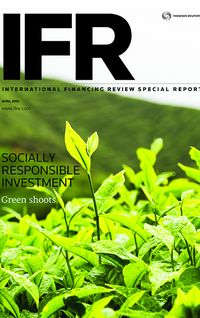Divergent views on definition may be a minor hindrance, but bonds that seek to enhance social well-being are on the rise.
In the hot and humid jungle city of Manaus in northern Brazil, work is under way to create school places for 18,000 new students as part of a broader push to boost education provision in the Amazonas – a region blanketed in dense rainforest and where isolated rural communities, often accessible only by boat, lack basic schooling.
The project is being funded by the Inter-American Development Bank with cash raised from its Education, Youth and Employment, or EYE, bond programme – a scheme designed to improve social outcomes in Latin America and the Caribbean.
IDB’s EYE deals are part of a small but growing market for bonds where proceeds are being used for specific social impacts that are distinct from but sometimes lumped together with the wider Green bond market.
Yet while the volume of Green bond issuance is well documented – around US$17bn had been sold globally by mid-April, more than double what had been issued by the same stage in 2015, according to Dealogic – tracking Social bonds is more challenging. That is because what constitutes a Social bond can mean different things to different people. Dealogic, for instance, lists the IDB’s US$500m 1.50% EYE bond due 2018 as a standard sovereign, supranational and agency bond.
Part of the problem is that the term ’Social Impact bond’ often refers to a type of debt where lenders are repaid based on the success of an underlying social goal. In 2010, for example, UK non-profit organisation Social Finance issued a Social Impact bond linked to prison reoffending rates in Peterborough, where investors would only get their cash back if the number of recividists fell by a certain amount. Social bonds, on the other hand, repay investors in the same way as a normal bond.
What’s in a name?
“There is a lot of confusion around terminology,” said Manuel Lewin, head of responsible investment at Zurich Insurance Company in New York. “We’ve had some transactions that have been more marketed as Sustainability bonds, as Social bonds, ESG (environmental, social and governance) bonds. As happened with Green bonds, having at least some consensus emerge about what it means to be a Social bond and having issuers bound by that is going to help.”
That could happen as soon as this year. The International Capital Markets Association, the group that oversees the principles governing the Green bond market, is planning to introduce a similar set of voluntary guidelines for Social bonds, after a number of banks had lobbied for ICMA to explicitly include social debt within the Green bond remit.
“[Social bonds are] different enough and now becoming important enough to warrant their own framework,” said Spencer Lake, vice chairman of global banking and markets at HSBC, who is also chairman of ICMA’s board. “It was agreed at the last board meeting and these should be ready by the summer.”
Money managers reckon such a move would likely encourage more Social bond issuance.
“There’s a reason to be optimistic that if the social label was started to be used more broadly that the market will grow,” said Rob Fernandez, director of ESG research at Breckinridge Capital Advisors in Boston. “It certainly helps identify the underlying projects that are being financed in a very clear way for investors, so I can see it having a benefit in the same way as the green label has done for environmental financing.”
That also means borrowers who are seeking to issue Social bonds will need to step up reporting standards and give investors greater insight on how their cash is being spent. IDB, for instance, outlines exactly what projects it is funding with EYE bond proceeds and gives regular updates on their progress. But that level of reporting is not yet widespread, given the absence of any consistent guidelines.
“It’s not very well established,” said Vishal Khanduja, a fund manager at Calvert Investments in Bethesda, US. “It’s like the Green bond market was five years back. It’s at a stage where there are still differing definitions and different lines of reporting that issuers have. We don’t just want to know the use of proceeds, we want to see what happens to the project after they’ve received the money.”
Another challenge some investors might face is finding a credible second party opinion to evaluate any social impact claims.
“There is not the same kind of external expertise in this sector as there is in climate change,” said Philip Brown, managing director, debt capital markets at Citigroup in London. “When it comes to development finance in Latin America, the global leading experts in this field are the IDB and other DFIs (development finance institutions).”
Even so, the risks of greenwashing – when Green bonds are issued to make a borrower appear more environmentally friendly than it actually is – is less of a concern for the Social bond market.
Less contagion risk
“The risks of ‘social-washing’ is very minimal, not least because Social bond issuance is dominated by the development banks,” Brown said.
That dominance of development banks is unlikely to change either. Whereas the Green bond market has expanded to include corporate borrowers – Apple, for instance, recently issued a Green bond to finance clean energy projects across its business – bankers are not convinced the trend will extend to Social bonds.
“There isn’t a great pressure for institutions other than development finance bodies to be doing these things,” Brown said.
As a result, the list of Social bonds that have a specific use of proceeds mandate like the IDB’s EYE bond programme is notable for its brevity.
The World Bank’s International Finance Corporation has issued Banking on Woman bonds, which help channel funds to female entrepreneurs in developing economies, particularly in sub-Saharan Africa and East Asia. The IFC has also issued an Inclusive Business bond aimed at funding firms in low-income communities. Both types of bonds were marketed only to Japanese investors.
The International Finance Facility for Immunisation has issued a series of bonds to help fund its vaccine programmes in some of the world’s poorest countries. It has sold debt in Japan, the UK and Australia, as well as offering deals in the sukuk market.
Spanish state-backed financing agency Instituto de Credito Oficial has issued a Social bond aimed at boosting employment by providing funding to small and medium-sized companies located in the country’s more financially troubled regions.
And Lloyds Bank has issued ESG bonds that, similar to ICO’s deal, were intended to fund loans to companies in the UK’s most economically deprived areas.
Make you own mind up
That scarcity of supply means that, for now, asset managers are having to make up their own definitions of what constitutes a Social bond and then dig through more traditional debt issuance to find bonds which match those criteria.
“You have to go and search for it,” said Simon Bond, portfolio manager of Columbia Threadneedle’s UK Social bond fund, which relies on the social guidelines set by fund partner Big Issue Invest.
Bond said the company carried out an analysis of the roughly 1,000 bonds in the non-Gilt UK bond index and found that around a third of the market conformed in some way to those social guidelines.
Those bonds include issuance from UK charities, such as the Charities Aid Foundation, housing association debt and bonds issued by the Greater London Authority to fund public transport projects in the capital, such as Crossrail, which some have dubbed Boris Bonds after London Mayor Boris Johnson. Universities have also been issuing debt that Bond says meet the social aims of his fund.
“The research and the breakthroughs that [universities] make is one of the social characteristics we look for,” said Bond.
Some socially responsible investors in the US are adopting a similar approach. Calvert Investments’ Khanduja said his firm does not have a strict definition of what a Social bond is, but there are a number of social outcomes that can qualify.
“We look at it from different angles: things like job creation, healthcare and education,” he said. “An example would be a bond that we bought from the YMCA of Greater New York – they don’t call it a Social bond but they offer a very clear-cut definition of what kind of impact they are having in the community through the programmes that they run.”
Others have an even broader starting point.
“We think about all fixed income as having a social purpose, and from there we differentiate what we consider to be the depth of that social purpose,” said Carole Laible, chief executive officer at Domini Social Investments in New York. “There is a lot of good debt out there that has a great social impact story. It’s just a matter of finding them, and I don’t think they necessarily need to come with a seal-of-approval wrapper. You just know it when you see it.”
But while the definitions remain diverse, one characteristic that bond investors agree on is that buying social debt should not mean sacrificing any financial return.
“The way we sell the fund is that you should expect to get returns that are associated with the risk you’re taking,” said Bond at Columbia Threadneedle. “You shouldn’t have to give up any return; you can have your cake and eat it.”
To see the digital version of this special report, please click here
To purchase printed copies or a PDF of this report, please email gloria.balbastro@thomsonreuters.com



